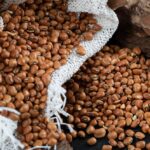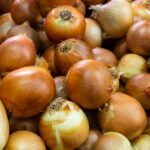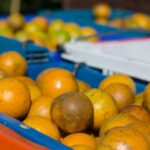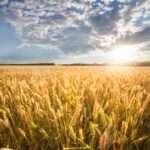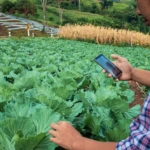In the age of technology, farming has undergone a major transformation. Gone are the days when farmers had to be physically present on their fields or farms to monitor and manage their operations. With the advent of remote monitoring technology, farmers can now keep an eye on everything—from livestock health to irrigation systems—right from the convenience of their smartphones. This shift not only increases operational efficiency but also helps farmers make data-driven decisions, optimize resources, and maintain a high level of control over their farm without being on-site 24/7.
What is Remote Monitoring?
Remote monitoring refers to the use of technology that allows farmers to oversee their farm operations from a distance. This technology typically involves sensors, cameras, and other IoT (Internet of Things) devices that collect real-time data on various aspects of farming. The data is then transmitted to a central platform, often accessible through an app on a smartphone or tablet. Farmers can use this data to monitor conditions such as soil moisture, crop health, livestock activity, and weather patterns, and adjust operations accordingly—all without having to be physically present.
Key Features of Remote Monitoring for Farms
Remote monitoring systems come with a variety of features that help farmers optimize their operations. Below are some of the most valuable features these systems provide:
- Real-Time Data Collection: Remote monitoring systems gather real-time data on everything from temperature and humidity to soil moisture and livestock movements. This constant flow of data allows farmers to make timely decisions and respond to any issues as they arise.
- Automated Alerts: Many systems are designed to send automated alerts to farmers in case something goes wrong—whether it’s an equipment malfunction, an animal straying from the herd, or a shift in weather conditions. These alerts help prevent major problems and enable quick responses.
- Remote Control of Farm Systems: With remote monitoring, farmers can control various systems from their smartphones. For instance, they can adjust irrigation schedules, turn on or off automated feeders, or even control climate systems in greenhouses. This level of control allows farmers to make adjustments as needed, no matter where they are.
- Data Analytics: Remote monitoring systems often include analytics tools that provide valuable insights. These tools can analyze data trends and generate reports that help farmers optimize operations, improve efficiency, and make informed decisions about planting, harvesting, and resource management.
- Energy and Resource Efficiency: By continuously monitoring farm systems and resource usage, remote monitoring tools can help farmers identify inefficiencies. This might include wasted water in irrigation systems, underutilized energy resources, or inefficient feeding schedules for livestock.
Benefits of Remote Monitoring for Farmers
- Increased Efficiency and Productivity: With remote monitoring, farmers no longer need to be on-site at all times to check on their operations. This increases overall efficiency and frees up time for farmers to focus on other critical tasks, such as analyzing data or exploring new farming techniques.
- Cost Savings: Remote monitoring systems help farmers save money by identifying inefficiencies and areas where resources are being wasted. For instance, optimizing irrigation schedules can reduce water consumption, while monitoring livestock can help prevent costly health issues.
- Better Decision-Making: With access to real-time data and analytics, farmers can make more informed decisions. Whether it’s adjusting irrigation practices, altering feeding schedules for livestock, or predicting weather-related challenges, remote monitoring helps farmers respond to conditions promptly and intelligently.
- Improved Sustainability: By reducing water waste, optimizing energy usage, and minimizing unnecessary labor, remote monitoring contributes to more sustainable farming practices. It helps farmers use fewer resources while still maintaining high levels of productivity.
- Peace of Mind: Perhaps one of the most significant advantages of remote monitoring is the peace of mind it provides. Farmers can stay connected with their operations no matter where they are. Whether they are at home, in town, or traveling, they can monitor their farm in real-time and take immediate action if needed.
Applications of Remote Monitoring on Farms
Remote monitoring technology can be applied across different areas of farming, including crop management, livestock monitoring, irrigation control, and even greenhouse management.
1. Crop Monitoring
Farmers can use remote sensors to monitor soil moisture, temperature, and nutrient levels in real-time. This helps them determine when crops need water, fertilizers, or pesticides. By automating this process and using data-driven insights, farmers can significantly improve crop yields while reducing waste.
2. Livestock Monitoring
Farmers with livestock can use remote monitoring technology to track animal movements, monitor health conditions, and ensure that animals are well-fed. Wearable sensors can detect issues such as reduced activity levels, which may signal health problems, allowing for early intervention and reducing the risk of disease outbreaks.
3. Irrigation Control
Smart irrigation systems linked to remote monitoring apps allow farmers to control their irrigation systems based on real-time data from soil moisture sensors and weather forecasts. This ensures that crops receive the optimal amount of water, preventing over-irrigation or under-irrigation, both of which can harm crops and waste valuable water resources.
4. Greenhouse Monitoring
In greenhouse farming, controlling the internal environment is crucial for maximizing plant growth. Remote monitoring systems can track variables such as temperature, humidity, and CO2 levels. Farmers can use these systems to ensure that the greenhouse conditions are always optimal for plant health, improving yield quality and reducing energy costs.
Best Remote Monitoring Apps for Farmers
Several apps are making remote monitoring more accessible and effective for farmers. Here are some of the top options:
1. AgriWebb
AgriWebb is an innovative farm management app that provides real-time insights into livestock and crop operations. It’s especially popular for its intuitive interface, which makes it easy for farmers to monitor and manage their farm remotely. The app also includes features for tracking farm performance, managing inventory, and generating reports.
2. CropX
CropX offers remote soil monitoring and irrigation management solutions. It helps farmers optimize irrigation schedules and water usage by providing real-time data on soil moisture levels. The app’s remote monitoring features make it an excellent choice for large-scale farms looking to improve water efficiency.
3. FarmLogs
FarmLogs is an all-in-one farm management app that helps farmers track weather, field conditions, and crop performance. The app provides insights into yield predictions, planting schedules, and irrigation needs, making it a valuable tool for both crop and livestock farmers.
4. Farmers Edge
Farmers Edge uses remote sensors to provide comprehensive farm management solutions. The app allows farmers to monitor soil health, weather conditions, and field performance, making it easier to manage resources and improve efficiency.
Remote monitoring is revolutionizing the farming industry, offering farmers the ability to control and manage their operations from the palm of their hand. With access to real-time data, automated controls, and valuable analytics, farmers can make informed decisions that increase efficiency, reduce costs, and enhance productivity. As technology continues to advance, remote monitoring will play an even greater role in the future of agriculture, helping farmers adapt to the challenges of modern farming while optimizing the use of resources. For farmers in South Africa and around the world, remote monitoring offers a smart solution to staying connected, efficient, and sustainable in an ever-changing agricultural landscape.



